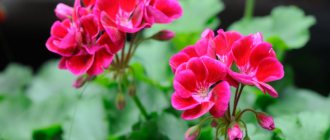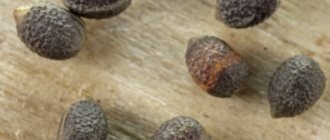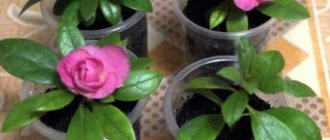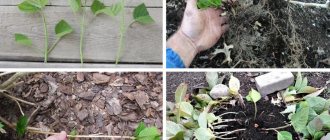Azalea propagation technology
Cuttings
The cuttings are cut with a blade or a sharp knife, previously disinfected with alcohol or a solution of potassium permanganate. Suitable cuttings are selected (see above), and the leaves at the bottom are torn off. The cut is made obliquely, at an angle of 45˚, 1 cm down from the lower bud. In order for the cuttings to take root better, they must be soaked in one of the rooting preparations.
Expanded clay is poured into the prepared pots or tray with a layer of 2 cm, then a layer of sand is 1 cm, and soil for azaleas is laid on top. When planting, shoots should be deepened by 2-3 cm, compacting the soil around with your fingers. Water the seedlings thoroughly. Be sure to build a “mini-greenhouse” so that the film does not touch the cuttings. (see video)
It is important! For the best rooting of cuttings, it is necessary to spray, provide oxygen (ventilation) and the room temperature should be at least 22-25˚C.
Seeds
The tray and soil mixture are prepared in the same way as for cuttings. The seeds are laid out on the surface of the soil and sprayed thoroughly. The tray is covered with glass or film and placed in a bright place. It is necessary to regularly ventilate the crops and spray them with water softened with a few drops of lemon juice. When the first shoots appear, the film should be removed immediately. When the first leaves appear on the seedlings, the seedlings dive into small pots with azalea substrate.
Remember! An azalea seed germinates only in the light!
Vaccination
One cutting of an azalea variety that is difficult to take root (scion) is carefully selected. An easily rooted azalea variety is used as a rootstock. The rootstock branch is cut so that the thickness of the cuts coincides. The grafting parts are combined and securely fixed. A “mini greenhouse” is installed above the plant, and the plant is shaded for the first time. After grafting, the seedling must be carefully looked after so that the cuts grow together safely. The connected parts must not be damaged. Reproduction of azaleas by grafting is a rather difficult operation that requires certain skills.
Dividing the bush
The plant is immersed in water for 15 minutes so that the soil is well saturated with moisture, and the water is allowed to drain for some time. Using a sharp, disinfected knife, divide the bush into 3-4 parts, trying to preserve part of the root system in each division. When the roots are intertwined, they are carefully untangled by hand. Part of the plant with a lump of earth is placed in small pots with a diameter of no more than 5 mm to prevent the roots from rotting.
The cuttings are planted at the same level as they were before planting. The voids are filled with disinfected soil. A prerequisite is drainage at the bottom of the pots. After a year, the bushes are transplanted into pots of larger diameter. When transshipping, they try to preserve a lump of earth so as not to damage the root system.
Which pot should I put it in?
Since not all rhododendron shoots can be rooted well even with careful care, experienced gardeners grow five or more young plants at a time .
In this case, a greenhouse is built. For this purpose, take a box or box and, after planting the cuttings, cover the container with film or a light-transmitting cap to maintain a comfortable temperature for the young animals of 22-25 degrees. The plants are planted at a distance of 4 cm from each other. If you manage to obtain single cuttings for planting, you can use small pots with a diameter of 5-7 cm, which will need to be covered with a transparent bag or a cut plastic bottle.
Periodically, the container with seedlings needs to be ventilated to prevent the shoots from rotting. It is also necessary to turn it towards the sunlight with the opposite side for uniform illumination.
The cuttings rooted in the box are planted in separate pots, not earlier than they have begun to grow well. The size of the individual bowl should be slightly larger than the root ball with soil. As it grows, you can transfer it to a larger pot.
Azalea is not an easy plant to propagate and requires a lot of effort and attention , so you should approach every step of cuttings responsibly!
What is cuttings
How to propagate petunia by cuttings in spring
The method of vegetative propagation of a plant, when a part (cutting) separated from the parent plant is used, is called cuttings.
Important! By cuttings, new plants are obtained with the same species and varietal characteristics as those of the mother specimen. Other methods do not always give this effect
The cutting method has been used for plant propagation for about 150 years. This method is widely used in indoor floriculture and ornamental gardening, forestry, etc.
Propagation by stem cuttings is the main method of obtaining planting material for some fruit, berry and ornamental species (currants, grapes, etc.). This process of growing crops requires certain conditions. It is best to cut cuttings during active growth of shoots, and growth stimulants are used to quickly root cuttings.
There are several techniques for cutting cuttings, depending on the plant’s ability to root. This can be a cut at the internode, hammer-shaped, nodal, etc.).
Description of Rosalia
Rosalia, also known as garden azalea, belongs to the heather family. This shrub is found almost anywhere in the world, but it comes from the eastern part of the Eurasian continent - China, Japan. Depending on the variety, rosalia can be deciduous or evergreen, and the height of its bush can reach 3 m.
Breeders have developed several varieties of rosalia that can be cultivated in the central zone of our country, increasing its frost resistance and resistance to bad weather conditions. We mainly plant deciduous varieties of plants - this tradition dates back to pre-revolutionary times, when parks near Moscow and St. Petersburg were landscaped and decorated with rosalia.
Rosalia bushes consist of many graceful shoots with light bark. At their tops there are dense leaves of an even elongated shape collected in bunches. Their outer side is shiny, covered with wax, and the lower side has a little fluff. During flowering, many buds appear at the joints of the leaves, which, when blooming, form a voluminous cap. Depending on the variety, the inflorescences are of a single or variegated color, terry or funnel-shaped. The cap is so dense that it seems that the bush consists only of inflorescences - the leaves are practically invisible through it. The lush appearance of the bush can be enjoyed from 3 weeks to 2.5 months.
Like its close relative, the indoor azalea, rosalia needs to be properly cared for. The main requirement for its successful maintenance in the open ground was the preparation of the soil and the selection of a place for planting. Rosalia, like all rhododendrons, likes acidic soil, around 3.5-4.5 pH.
General information about azalea
Rhododendron is a unique flower. This is one of those plant species that has existed on the planet for several tens of millions of years. In this case, the age of the culture is no less than 50 million years. Of course, the ancient ancestors of modern azaleas are plants that are somewhat more primitive and at the same time resistant to changing environmental conditions. Unfortunately, the high level of the body's defenses failed to prevent the death of a significant part of rhododendrons as a result of the onset of the Ice Age. Therefore, the habitats of plants differ in climatic and geographical characteristics. Modern azalea can be found in nature in the Land of the Rising Sun, the Himalayas, New Guinea, the Middle Kingdom, and northern Australia. In total, rhododendron today has at least a thousand species.
Externally, azalea looks very attractive
: due to evergreen foliage, neat shape and large graceful flowers with delicate petals and delightful colors. Rhododendron flowering lasts less than a month, but this process occurs in winter and early spring, when the heart asks for at least a grain of warmth. There are early, mid-late and late varieties of azaleas.
Rhododendron will help you treat certain diseases, such as stye, and restore visual acuity. In the first case, you need to make applications on closed eyelids from azalea leaves, and in the second, just admire the lush flowers for 20 - 30 minutes. A charming plant that deserves to decorate every home.
How to choose the right plant?
Tips for choosing Azaleas are about the same as for buying most indoor plants:
- It is preferable to choose a flower on which the first buds have just appeared. It is worth adhering to this rule first of all, since the plant in any case experiences stress when moving from its usual environment. But it was noticed that not in a blooming state, Azalea quickly adapts to new conditions.
- It is recommended to evaluate the external condition of the bush. To do this, it should be carefully tilted. If there are fading or even dry leaves at the base, then it is obvious that such an Azalea grew in an uncomfortable place. There is a risk that she will not survive the move and will quickly wither away.
Azalea in a pot
If you purchase a plant that is already flowering, then the only recommendation is not to try to immediately transplant it into a new pot. It is better to wait until the flowering ends or at least its peak. Otherwise, there will be very little chance of successful survival of such a magnificent flower.
How to propagate azalea at home
The process of cutting a plant consists of three main stages. Let's look at each of them in detail.
Separation from the mother flower
When performing the procedure for separating a cutting from the mother plant, you should adhere to the following recommendations:
- All garden tools must be sterilized before use. This is done in order not to spread the infection from other plants.
- The branch for cutting is selected to be healthy and corresponding to the parameters specified for different types of azaleas.
- The cut of the cutting is made under the lower bud, with an indentation of 1 cm. The cut is made at an angle of 45 degrees, several lower leaves are removed.
- The resulting seedling is treated with the selected growth stimulant.
The following drugs can be used to stimulate growth:
- Heteroauxin - a fifth of the tablet dissolves in half a liter of water. Plant cuttings are dipped into the resulting mixture and kept there for no longer than 6 hours.
- Zircon - dispensed in liquid form, 10 drops are dissolved in the same volume of water. Soaking lasts longer - one day.
- Kornevin - in terms of application, it is radically different from previous drugs. The drug powder and activated carbon crushed to a dusty state are mixed in equal quantities. Then the sections are sprinkled.
Landing
Cuttings of azaleas at the planting stage require the following activities:
- Planting in the ground is not carried out without first soaking it in a root growth stimulator.
- Before the planting procedure, additional treatment of the sections is carried out with a weak solution of potassium permanganate.
- Planting is done in moist soil, with the cuttings deepened by 2-3 cm.
- The final step is to cover the frame with a plastic bag and dark cloth. This step should be performed if the dark rooting option was chosen.
How to root an azalea at home
To achieve successful growth of azalea roots, the improvised greenhouse should be placed in a warm place where direct sunlight does not reach.
In addition, certain conditions must be met:
- air temperature 22-25 degrees;
- humidity not lower than 80%;
- in the cold season, the soil is additionally heated using a battery or an incandescent lamp.
Further care consists of daily ventilation of the plant. The film is removed from it for 30-40 minutes, it is better to do this before noon. Instead of watering, spraying is performed; the soil should be constantly moist. Once every 7 days, citric or oxalic acid can be added to the water at the rate of 2 g per liter.
As many cuttings as possible should be rooted, since the chances of their further development are low. If 3-4 adult plants are obtained from 20 cuttings, this can be considered a success.
Care after root germination
If the recommendations on how to root an azalea from a cutting have been followed, and the plant has begun to grow (new leaves have appeared), then the care tactics need to be changed. Plants are planted in separate containers from a common tray, but before this a kind of hardening is performed. On the first day, the flower is left without film for two hours, with each subsequent day the time is increased by an hour and a half. After 6-7 days you can start transplanting.
Further care actions do not differ from those recommended for an adult plant. The only nuance is that if buds form on the azaleas immediately after transplantation, they must be cut off in order to preserve the flower’s strength for development.
Cutting an azalea is a very troublesome task, but it will have to be done if you want to propagate a beautiful flower. By following these tips and sequence you will be able to achieve success.
It is important to remember that only 1-2 cuttings out of 10 take root, so you need to plant as many shoots as possible. Considering the constant need for pruning and formation of an adult bush, there will be no shortage of planting material
Also read our article “How to revive an azalea if it has dried up.”
How to properly propagate a flower using cuttings, step-by-step instructions
The azalea has faded, what to do next - caring for the plant after flowering
Many, having seen how this Japanese flower blooms, want to grow it on their site. It is not necessary to buy a ready-made plant in a store; you can get a ready-made seedling from an adult bush. Before propagating azaleas, you should familiarize yourself with the rules of cuttings.
Azalea cuttings
Separation from the main flower
Young healthy shoots are chosen as the material. Use sterilized garden tools - a knife, pruning shears, scissors.
- The cutting is cut at an angle of 45 degrees, 1 cm away from the lower bud.
- The lower and upper leaves are removed, leaving 4 leaves, cutting them in half.
- The cut is treated with a root growth stimulator, the cutting is left for several hours so that the stem dries out and is saturated with Kornevin.
Their survival rate depends on how well the cuttings are selected for germination.
How to plant
Before planting in the ground, the cuts are treated with a solution of potassium permanganate. The stems are planted in the ground at right angles to a depth of 3 cm. The soil should be highly acidic. Soil for azaleas is sold at gardening stores. Prepare the mixture yourself, combining pine litter, sand and peat in equal proportions.
Attention! You can prepare the soil for seedlings yourself. Before planting the cuttings, the soil is calcined in the oven.
After planting the cuttings in a pot, cover it with film and place it in a warm place.
Rooting cuttings
Experienced flower growers know how to root an azalea in water using a growth stimulator. You can try this option for experimental purposes. Great results can be achieved by rooting cuttings in the ground.
The conditions for the survival of the stems are sufficient watering and the presence of a greenhouse, which must be constantly ventilated.
The seedlings are provided with a house temperature of +22..+25 degrees, humidity of at least 80%.
Rooting cuttings
Reproduction of azaleas at home by cuttings
After the inflorescences wither, azaleas are often thrown away. The plant can be easily propagated at home.
In indoor conditions, it is quite easy to propagate azaleas by cuttings. It is advisable to carry out the procedure in the spring and summer. For quick rooting you need:
- Prepare an acidic, nutritious substrate.
- The size of the cuttings should be at least nine centimeters. The lower part of the shoots must be cleared of leaves. Several vegetative organs can be left on top of the stem.
- It is recommended to make a side cut directly below a group of leaves or a bud.
- To grow a lush plant, you should use a beautiful flowering azalea. It is not recommended to take shoots from damaged or infected crops.
- Cuttings for propagation can be cut no more than once a year.
- To stimulate the formation of their own roots, the cuttings must be placed in a stimulant solution. It is enough to dilute two Heteroauxin tablets in one liter of water at room temperature. A tied bunch of fifteen cuttings must be lowered into a container with the drug. After six hours, the shoots are ready for planting. You can also use effective preparations for azaleas - “Zircon” and “Kornevin”.
- The treated stems are transferred to a nutrient substrate. The planting depth should be no more than four centimeters. It is necessary to maintain a distance between shoots - about three centimeters.
- For planting, it is recommended to use shallow containers, bowls or small greenhouses.
- At the bottom of the container, be sure to lay out a drainage layer of no more than three centimeters. It is advisable to use expanded clay, pebbles, gravel or pieces of broken dishes.
- On top you need to pour two handfuls of clean sand of medium grain size.
- The pots should be filled with a prepared mixture of coniferous soil and softened peat.
- The planted cuttings must be covered with plastic wrap.
- The azalea should be sprayed daily.
Vermiculite can also be used for spreading. The soil mixture promotes rapid rooting of cuttings.
It is important to provide the azaleas with the proper conditions. The temperature should be maintained at about + 25 degrees
The relative humidity level should be at least 80 percent.
In a favorable environment, shoots will be able to take root in 45-60 days. By this time, the cuttings will have their own massive root system.
A room temperature below + 22 degrees will destroy planting material. Experienced gardeners recommend heating the substrate with warm heating pads.
Transfer
How and when to replant an azalea at home?
Azaleas are replanted in the spring, after flowering.
It is not recommended to replant azaleas during budding and flowering.
Otherwise, the plant may lose buds, flowers and leaves. It will be difficult to save him.
How to replant an azalea? When transplanting an azalea, it is important to know that it has a very sensitive root system, which has its own microflora. Mushrooms live on its roots, providing the azalea with adequate nutrition.
Therefore, it is very important not to disturb this symbiosis during transplantation.
You can take a ready-made mixture called “Azalea” or prepare the soil yourself by taking 1 part peat and 2 parts rotted pine needles. Or you can mix peat, humus, sand, turf and leaf soil in equal parts and add 5 parts of coniferous soil to them. Another option:
- part of sand
- part of dried and crushed sphagnum moss
- 2 parts of rotted pine needles.
For azaleas with a shallow root system, the new container should be selected wide enough and not very deep, but 5 cm higher than the previous one.
A layer of drainage at least 3 cm thick in the form of large expanded clay or broken shards is placed at the bottom of the pot. A layer of pine bark is placed on the drainage (it helps increase the acidity of the soil), and then the container is filled with prepared soil. It is useful to add Trichodermin to the substrate to prevent fungal infections and rot.
Before transplanting azaleas, cut off dry twigs and faded buds and clear the stems of dried leaves. Next, the bush, along with a lump of earth, is taken out of the pot and placed with its roots in a basin with filtered or boiled water and “Kornevin” or “Zircon” dissolved in it.
The procedure is repeated, changing the water twice. The roots of the azalea are very tightly entwined with a lump of earth, so it is impossible to completely remove it, and it is not necessary. However, such bathing helps to wash away most of the salts that have accumulated in the soil over the year.
Before immersing the plant in water, it is recommended to make cuts in the earthen coma using a knife - these should be grooves about 0.5 cm wide on the sides, bottom and top. This will help the roots become saturated with moisture, making it easier to settle in and germinate in the new soil. Otherwise, they will not be able to receive enough nutrients and will dry out, which can lead to the death of the plant.
After part of the soil (usually no more than a third) is washed away from the roots, you can begin replanting, or rather, transferring the flower into a new pot. It is taken out of the basin and, when the water has drained, placed in the center of the container, and then the roots are evenly sprinkled with earth, lightly tamping
It is very important not to bury the root collar of the plant.
If the azalea has grown too much, it is divided into bushes by cutting the root ball into several parts according to the number of divisions. Each bush with a lump of earth is placed in a separate pot.
What to do after transplanting an azalea?
After transplantation, the azalea is watered generously with the water in which it was soaked and placed in a warm and bright place with shade from the sun's rays. Watering is repeated after four days. The plant is kept in partial shade for about 12 days. It is useful to spray a flower that has not yet matured after transplantation with Zircon or Epin.
You should also protect the weakened plant from drafts. You should not immediately fertilize the transplanted flower; you must give it the opportunity to adapt and get stronger.
Replanting after purchase
It is not advisable to immediately subject a newly purchased azalea to the transplant procedure. Let the plant remain in quarantine for several days - separately from other flowers.
During this time, it will adapt to unfamiliar conditions and will be able to move painlessly to a new pot.
Often, azaleas are sold in the store in bloom and, according to the rules, they cannot be replanted at this very moment.
However, if it is flooded and sick or its capacity is clearly too small, you can make an exception and change the soil and pot for the plant
But this must be done very carefully, using the transshipment method, only slightly cleaning the root ball
The transshipment method is also used when transplanting Koleria, Aloe, and Poinsettia succulents.
Read more about transplanting azaleas in the video below:
Needless to say, replanting and propagating home azaleas requires diligence and patience. But all your efforts will pay off handsomely, because your collection will be replenished with one or more plants of extraordinary beauty.
Aftercare
Young plants grown from seeds, cuttings or by dividing a bush need to be provided with the most comfortable living conditions.
- They should receive enough light during the day and be regularly sprayed with warm water.
- The full development and growth of plants largely depend on lighting, so in the cool season, young azaleas should be provided with additional light. From time to time, flower pots must be turned to ensure uniform formation of the above-ground parts. Plants should be carefully protected from direct sunlight.
- In the warm season, it is recommended to ventilate the room where azaleas grow. These plants need good air circulation and oxygen flow. During ventilation, flower pots are removed to protect them from drafts.
- Watering is carried out as the surface layer of soil dries. The soil in the pot should not be allowed to dry out.
- To increase the acidity of the soil, to which azalea is very favorable, it is allowed to spray the soil once a week with a weak solution of citric acid (2 g of substance per 1 liter of water).
Ways to propagate azaleas at home
Azalea is one of the most showy flowers in a plant lover's home collection. Its peculiarity is its lush flowering in winter.
The color and shape of the petals can be very diverse - double, simple, white, red, purple, two-color. This culture requires compliance with the temperature regime, otherwise leaf fall cannot be avoided.
The flower will be a wonderful gift, or you can grow it yourself. But to do this you need to know how to propagate azaleas at home.
Azalea domestic
Growing azaleas from seeds
Propagation of azaleas by seeds is a complex process; germination of seed is up to 70%. In March, seeds purchased in a store or collected from an adult flower are sown. Sifted sterile peat is used as soil and seeds are sown on it. Cover the pot with glass and place it on the sunny side.
Water with a spray bottle and periodically ventilate the greenhouse. Seed germination can take up to 3 weeks.
You should know! Growing azaleas from seeds is the most difficult method of propagation.
After the first leaves appear, the sprouts are planted in separate containers, deepening the stems to the leaves. Until the end of summer, seedlings develop in boxes; at the end of August, grown plants are planted in large pots. The container should not be much larger than the previous one in volume.
Dividing the mother bush
Perennial formed azaleas are often sold in stores; they can be propagated by dividing the bush. The manipulation is carried out after flowering has stopped.
Place the pot with the plant in a bucket of warm water for half an hour to soak the soil. The wet root part is removed from the container and left to dry for several hours.
Carefully divide the overgrown bush into several formed parts, helping with a sharp knife
Dividing an azalea bush
Remove damaged roots and plant bushes in azalea soil. The crown is covered with a jar or bag. Observe the rooting process of the tree, periodically opening the greenhouse. After a few weeks, the plant is left without shelter and cared for as an adult flower.
Growing azaleas by cuttings
For propagation, you need to choose an old, lignified cutting.
They cut it at an angle of 8 cm. The procedure is carried out from March to early summer. The stems are treated with a root stimulator and planted vertically in an acidic substrate to a depth of 2.5 cm, pre-treated with a solution of potassium permanganate.
The plantings are covered with film or a jar and periodically sprayed with a spray bottle, checking the soil moisture. It is necessary to provide the cuttings with a temperature of at least +25 degrees. After 3-5 weeks, roots appear and seedlings are planted in permanent soil.
Important! To root cuttings, the room must be at least +25 degrees. Cuttings of azaleas is one of the most effective ways of propagating them.
The advantage is a large amount of material for planting. After all, from one bush you can get many branches suitable for cultivation
Cutting an azalea is one of the most effective ways to propagate it. The advantage is a large amount of material for planting. After all, from one bush you can get many branches suitable for cultivation.
For comparison:
- propagation by seeds is an ineffective method in which it is very difficult to grow a seedling;
- To divide a bush, a perennial healthy bush is needed.
But cuttings can be cut in large quantities from a young plant. The stems of the tree have good survival rate due to the high ability of the culture’s own cells to form new tissues.
Attention! It is better to try to germinate several cuttings at once to increase the chances of getting a strong plant.
Difficulties and problems
Often, difficulties in growing azaleas discourage inexperienced gardeners from taking cuttings of this flower again. It happens that plants die for no apparent reason in the first weeks, and sometimes they simply do not grow after the allotted time. Therefore, it is important to take into account not only the stages of planting the cutting itself, but also the following points:
- take seriously the choice of shoots, processing of tools and soil;
- assess the maturity of the plant from which the cutting is taken and make sure that its flowering period is over;
- take into account the possibility of organizing the desired temperature regime and heating the box from below if necessary;
- avoid drafts;
- for cuttings in winter, prepare additional lighting;
- constantly maintain air humidity in the greenhouse by regular spraying;
- do not allow the soil to become waterlogged when watering or dry out;
- inspect the plant for pests.
Is it possible to propagate azaleas at home?
amoretto san-amore
Yes, azaleas can be propagated by cuttings, but with the help of heteroauxin (from my own experience). I have not seen rooted cuttings of azaleas sold in a store. Azaleas are very difficult to keep indoors because they love cool, moist air. So I had to make a special window for them. But in winter it was a fairy tale. In addition, they need acidic soil, which I brought from the dacha or took from the Botanical Garden. These are the main conditions for breeding and growing azaleas. In general, this is not an easy plant for beginners. Good luck
Lampard
It is very difficult to propagate an azalea; it is unlikely that you can do it at home; it is much easier to buy rooted cuttings in a store. Azalea loves cool air temperatures around and warm water for irrigation, and loves melted snow warmed by room temperature. Spray except during flowering period. Loves acidic soil - 2 aspirin tablets 1 liter of water. and water generously. Pots should be wide and low, as azaleas have a shallow root system. Remove wilted flowers in a timely manner. Loves bright, diffused lighting. Water abundantly, the soil should be slightly moist, but do not allow overflow.
✿Elena m✿
It's easier to buy. All varieties of azaleas are propagated by semi-lignified cuttings, cutting them in two periods: from mid-March to mid-April and from mid-July to mid-August. In the spring, cuttings are taken from plants pinched in July last year, and in the summer - from annual plants. To do this, take shoots 7-9 cm long after pruning the plants. The three lower leaves on the cutting are cut off, leaving 0.5 cm of petiole. The remaining leaves are cut in half. The lower oblique cut is made under the bud itself, preferably under a group of crowded 3-4 leaves. Cuttings should be taken only from healthy and well-developed plants. You can cut them only once a year. Before planting, the cuttings are tied in 10-20 pieces and immersed with the lower cut in a heteroauxin solution (2 tablets per 1 liter of water) for 6 hours. After this, they are planted in bowls, boxes or greenhouses in a nutrient substrate to a depth of 2-3 cm according to a 4x4 cm pattern. Broken shards or gravel are placed on the bottom of the dishes in a layer of 2-3 cm, then a 3-centimeter layer of coarse sand is poured, and on top - 8-10 cm of coniferous soil or peat, or a mixture of coniferous soil and peat, covered with glass or translucent film and sprayed regularly. At normal summer temperatures of about 25°C and a relative air humidity of 80% in such a substrate, cuttings take root in 1.5-2 months and form a strong root system. A week after planting, the cuttings are ventilated every morning for an hour, lifting the film. As soon as the roots are formed and shoots begin to grow, the glass or film is removed, and the cuttings are watered and sprayed daily so that the substrate is moderately moist at all times; When young plants grow 2-3 cm, they are transplanted into other pots or an unheated greenhouse filled with 12 cm of coniferous soil.
Lana+
In general, azalea is considered an annual plant, so it’s better to buy a ready-made one, enjoy its flowering and throw it away!
Olga
you can, you need to take young shoots, azalyl from cuttings is less whimsical, but wait a long time for roots to appear (up to 8 months)
Aksana
If your hand is light, it will work. cut off large branches and place in water. the main thing is that they do not rot, change the water more often and wait for the result. Good luck!
Features of cuttings in different types of rhododendron
- In deciduous varieties, a young shoot with light-colored, partial-size leaves should be selected for rooting; the stem should bend easily, but not break. The bud at the top will be in the ripening stage. This is the growth of the last year, and it needs to be separated.
- In evergreen varieties, woody shoots are used. The leaves of the future plant should be dark-colored, of normal size, as on the mother bush, in an amount of at least five pieces.
How to determine that the shoot is ready for separation?
- Deciduous rhododendron cuttings are ready to be taken as long as they are soft in the stem and do not break.
- Evergreen varieties of rhododendron show readiness for cuttings with a dry crease of the stem. At the same time, the characteristic crunch of breaking wood is heard.
The cutting is always taken from an adult healthy plant without signs of visible external damage. Azaleas are pruned into cuttings once a year so that the mother plant has the strength to further ripen buds and flower.
Mature azalea bushes need pruning to form a beautiful and even crown, so even if it is not propagated, this is part of basic care.
Propagation by cuttings
Start working after the plant has finished flowering. This period occurs in the spring, but until the end of summer you can easily start producing young plants. How to take a shoot from an Azalea? Here are the steps to obtain them:
- Carefully inspect the Azalea and stop at the young, semi-lignified shoots. Do not touch the fattening shoots, but those that have grown from the tops of the current year are ideal.
- Using a sharp knife with a disinfected blade, make an oblique cut under the bud itself, where a group of 3-4 leaves is clustered.
- The three lower leaves need to be removed and the remaining ones thinned by half.
- All cut shoots must be immersed for 4–6 hours in a heteroauxin solution prepared from 2 tablets of the drug and 1 liter of water. Instead, you can use Kornevin or Zircon.
- Now prepare the substrate. I am often asked what kind of soil is needed for Azaleas? This can be slightly decomposed peat or special soil for Azaleas. You can mix peat with coniferous soil. Place drainage at the bottom, then a layer of sand, and only then the substrate itself, which needs to be moistened.
- Place the cuttings in it to a depth of 3–5 cm. If you plant the shoots all together in one box, then maintain a distance of 4 cm between them.
- The earth around them needs to be crushed well and each cutting should be covered with a jar or a transparent plastic bag should be pulled over the box, that is, you need to create a greenhouse.
- Your task is to spray the cuttings daily, or even two or three times a day, periodically ventilate the greenhouse and moisten the substrate with warm, settled water with a root formation stimulator diluted in it. In this case, the shoots should receive enough light, and the air temperature should be within + 25 ᵒС. Heating the soil will also help speed up rooting.
In 1.5–2 months, cuttings of indoor Azaleas will take root, after which the cover can be removed, but the plants need to be sprayed daily, as well as regularly moistening the soil. The shoots that have grown by 2–3 cm can be transplanted into a separate pot with coniferous soil and the apical branches can be pinched to form a thick and lush bush. Remove the first flower buds. I understand your impatience to see the color of your young Azalea, but for now your task is to increase the green mass, give the plant the opportunity to grow and strengthen.
In the spring, do the second pinching, removing 5-6 branches, and thus, after 3 years, you will get a full-grown adult plant, which may well become a garden plant and migrate under your windows for the summer.
Question answer
Is it necessary to cover the bowl with cuttings with dark material, as some sources advise?
No, don't. It is enough to place it in a place where the sun's rays do not reach. If you have to place the greenhouse on the windowsill, then it is best to stick dark paper to the bottom of the window glass.
How often should cuttings be sprayed during rooting?
The soil is moistened regularly, keeping it moist and preventing it from drying out. If you are going to spray and the ground is still wet, then postpone the procedure for a while. Check the condition of the soil every 3 - 4 hours, moisture from it can evaporate very quickly. If the moment of spraying is missed, it can be disastrous for the cuttings.
Why did the cuttings begin to rot three weeks after planting?
This can happen for several reasons:
- Lignified cuttings were taken for rooting, but they are not suitable for propagation;
- the soil is contaminated with fungal or bacterial spores, or the tools used for cutting shoots are not disinfected;
- The soil in the greenhouse is not heated enough. This is especially important when propagating azaleas in winter. For heating, a 60 W incandescent light bulb is suitable, the lamp with which must be placed under the box with cuttings. For example, a box with seedlings can be placed on a stool, and a lamp placed under it on the floor;
- Cold water was used to irrigate the cuttings.
How to speed up the rooting of cuttings?
In addition to stimulating root growth and heating the soil, you can speed up the formation of roots by spraying the cuttings with Zircon once a week. To do this, add 2 drops of Zircon to a glass of water.
How long does it take for an azalea cutting to root?
Rooting occurs in 1.5 - 3 months.
What is the easiest and fastest method of reproduction?
The easiest way is propagation by cuttings. Since an azalea bush must be formed annually by removing shoots, there is always a lot of planting material. There are times when cuttings do not take root, but this is rare. Flowering when propagated by cuttings can begin within a year. The buds begin to set earlier, but it is recommended to remove them so that the azalea can grow shoots.
Indoor azalea: plant care, azalea replanting, propagation.
Dry air in winter
Never allow the soil to dry out, as this may cause the plant to lose leaves. Irrigation water should not contain chlorine and lime. Chlorine is harmful to azaleas. Tap water must be kept for 24 hours so that the chlorine evaporates. It is good to water with snow and rain water. In summer, it would be good to install the azalea outdoors, but it does not like direct sunlight. If in winter an azalea can be watered every other day, then in summer it requires daily abundant watering, and spraying several times a day. When the azalea blooms, stop spraying. Azalea belongs to the heather family, so the best soil for it is heather. Since this soil is very rare (it is obtained from rotten stems, roots and leaves of heather), you can take a mixture of two parts leaf soil, four parts peat soil and one part sand. Or a mixture of equal parts of leaf, coniferous and compost soil with an admixture of sand (about 1/6 part). By the way, azaleas do not tolerate soil taken from under oak trees. Azaleas are replanted in the spring, when flowering ends, before new growth begins. The planting needs to be tight. It is advisable to saturate the lump of earth well with moisture. During transplantation, do not cut off the roots; even the smallest young roots should be protected. It is better to take pots that are low and wide. Make sure your pots have good drainage. After transplanting, you need to water the plant generously so that water seeps into the pan. During this period, it would be good to prune so that a thick, compact crown is formed. Flower buds form at the ends of annual shoots, which in good light and low temperatures should be thick and short with healthy dark green leaves. In order to form more buds, pinch the apical bud. Pinch it for the first time approximately 30 - 40 days after flowering, when the new shoots have the fourth pair of leaves. The last time you can pinch is no later than the first days of August, since buds begin to form at the end of summer, and pinching later can delay flowering. If sprouts appear near the buds, they must be removed, because then the buds may not open. After flowering, small shoots and faded tops must be cut off. At this moment, a “bath” with a weak solution of potassium permanganate will be useful for the azalea. Holding the pot so that the soil does not spill out, dip the plant into the bucket with the foliage down. Azaleas are propagated mainly by cuttings. You can do this in July-August and February-March. Semi-lignified shoots after pruning are taken for cuttings. In addition to the apical bud, they should have three or four more leaves. They are cut in half. The petiole should be left about 0.5 centimeters. The cuttings need to be planted shallowly, just to keep them going. After planting, they need to be watered generously and sprayed daily with water at room temperature until they are completely rooted. It would be good to cover them with plastic film, but do not forget to ventilate the young plants twice a day, morning and evening, by lifting the film. When they begin to grow, remove the film. From time to time, plants should be turned to the light on one side or the other so that they develop evenly. You can propagate azaleas by seeds, but you will have to wait a very long time for flowers - at least five years.
indasad.ru
How to care for indoor azalea? Video:
How to choose the right place for an azalea?
When deciding on the location of a plant, it is necessary to rely on its natural habitat. These are cool places full of clean air and diffused sunlight. Therefore, try not to place the plant pot in direct sunlight.
Temperature
Temperature conditions are very important for rhododendron. In nature, azalea lives in a cool climate; heat is destructive for it.
When the plant is in the stage of forming flower buds (October-November), the ambient temperature is maintained around 5–7 degrees. And during the flowering period, it should be increased by 6–10 degrees. 10–15 degrees Celsius are considered optimal.
Of course, what is good for azaleas is not very comfortable for people. Therefore, many gardeners are cunning and, to cool the plants, cover the pot with dry ice or often treat it with water from the refrigerator.
Choosing a place to plant garden azaleas
Further success in growing shrubs depends on the correct choice of place for planting azaleas. The plant needs diffused sunlight. Choose a shaded place for planting. It may be under the canopy of trees. However, not in dense shade. The best option is a plot located in the northern part of the garden or the side of the house. Then the sun's rays will illuminate it in the morning and in the afternoon.
Different varieties require a certain degree of shade. Evergreens like constant, indirect light, while deciduous varieties are best placed under the protection of tree canopy. Maple, linden, birch, elm, and willow are bad neighbors for rhododendron. These trees have shallow roots, so they take moisture from the azalea with its expanding roots. In the shade of oak, pine, larch, and fruit bushes, she feels great. Their central root tends to go deeper and receives water from there. The azalea will not bloom in strong shade, but in a sunny place it will bloom quickly, the foliage will turn yellow, the inflorescences will fall off, and the process of bud formation will deteriorate.
Garden azaleas need protection from drafts and wind. The corner of the building, windy areas between buildings are a bad choice. A place near a body of water with sufficient humidity is a good solution.
Group plantings consisting of three or more bushes with different flower colors look beautiful. Each bush is placed on 1 m2 of area. Deciduous and evergreen plants do not mix. The decorative effect is destroyed. They combine planting rhododendrons with thuja, decorative spruce, and yew. If you select azaleas with different flowering periods, they will decorate the area all summer.
It is important to consider the availability of groundwater. In places where azaleas are planted, moisture should not accumulate to prevent rotting of the roots. During snow melting, you should pay attention to this point.
Care and reproduction
In this article we will try to answer questions that interest many gardeners:
- how azalea flowers reproduce and how to care for them,
- how to breed and how to plant azaleas at home?
How to propagate at home?
You can propagate azaleas from spring to August in several ways: cuttings, seeds and dividing the bush. This is painstaking work that requires a fair amount of patience from the grower.
How does azalea propagate at home?
The most reliable method is considered to be propagation of azaleas by cuttings, which gives up to 90% success.
How to propagate indoor azalea at home from cuttings? This procedure is carried out as follows:
- After a healthy plant has flowered, cuttings about 10 cm long are cut from it - for this, the tops of six-month-old shoots are taken. The cuttings are cut obliquely directly below the bud.
- The three or four lower leaves are carefully removed, leaving petioles of about 0.5 cm, and the remaining leaves are cut in half.
- For better rooting, cut azalea cuttings are immersed in a solution of Zircon, Kornevin or Heteroauxin and left in it for 5-6 hours.
- Next, a layer of drainage up to 3 cm thick is placed on the bottom of the bowl or box and sprinkled with a layer of sand 2 cm thick. Then the container is filled with a nutrient mixture with an acidic reaction.
It is best to use ready-made soil for azaleas or a mixture of equal parts of coniferous soil (rotted pine needles) and peat.
The cuttings are planted in the substrate, deepening them to 3 cm and maintaining a distance of 4 cm between them. After this, the soil is thoroughly shed. The container with the cuttings is covered with film, thus creating a “mini-greenhouse”, and placed in a light, shaded place. Next, the cuttings are regularly sprayed and ventilated daily in the morning, opening the film for 35-40 minutes.
The soil should always be slightly moist. Experienced gardeners also recommend bottom heating.
At a temperature of 25 to 30 ° C and a humidity of 80%, the cuttings usually take root in a month or a month and a half, after which they can be transplanted into permanent pots. 7-8 days before transplanting, the rooted cuttings begin to “harden off”. First, the “greenhouse” is opened for a couple of hours, then for a longer time. After a week, the “greenhouse” is completely opened. Next, the cuttings are transplanted into separate containers and covered with film again for 11-12 days. After two to three months, the tops of the young bushes are pinched for the growth of new shoots and better tillering. If the plant has produced its first buds, it is recommended to remove them. After the azalea overwinters, it is pinched again in early March. In this case, you can trim up to 6 young shoots. Next, the plant is transferred to a new container with a diameter of about 11 cm with holes for water drainage and a good layer of drainage.
In the future, the young azalea is cared for like an adult. In a couple of years, it will reveal itself in all its glory and will delight the gardener with abundant flowering.
Many plants are propagated by cuttings at home, such as Impatiens, Crassula, Croton and many others.
Propagation of indoor azaleas by seeds is an even more complex and time-consuming process.
The seeds of the plant germinate with difficulty and do not retain varietal characteristics. In addition, they remain viable only for 3 months.
But it’s worth a try, because this is a very exciting process, as a result of which you can grow azaleas with completely unexpected flower colors.
The algorithm for planting seeds is as follows:
- In early March, small plant seeds are mixed with sand and sown on a moistened substrate surface. The container is covered with glass and placed in a sunny place - azalea seeds are photosensitive and germinate only under the rays of the sun.
- Next, regularly ventilate the “greenhouse” and water the substrate from a fine sprayer with soft and well-settled water. It can be softened with oxalic acid by diluting 4 g of the substance in 10 liters of water.
When watering, do not over-moisten the soil so that the seedlings do not rot.
If the seeds are fresh, the first shoots can be expected in 14-15 days or a little earlier. After 3 weeks, all seeds will germinate. Their germination rate is up to 70%. When the cotyledons are almost completely expanded, the seedlings, together with a clod of earth, dive into another container, maintaining a distance of about 3 cm between the sprouts. The seedlings are buried to the very leaves. The composition of the soil is the same as for cuttings.
How to care for an azalea when it has bloomed: what to do next?
Flowering azaleas is a wonderful process, but short-lived. As a rule, azalea blooms in winter and in the first half of spring, after which it enters a dormant period. It is very important to properly care for a faded plant in order to see beautiful flowers again and again; just because there are no more flowers, the azalea will not become more unpretentious, quite the contrary. She has more and more needs, without satisfying which the plant may even die. How to care for an azalea after flowering? What to do if it has bloomed and dropped its leaves or dried out? What mistakes do flower growers make and how to correct them? Read more...
Types and varieties of azaleas
Azalea on a trunk is a perennial ornamental plant, indoor and garden type. Outwardly it resembles a tree, which is achieved through pruning. The article will tell you about the characteristics of different types and varieties of plants, care rules and possible difficulties.
There are two main types found in home gardening.
Indian azalea (Rhododendron simsii)
Indoors it is small in size, ranging from 40-60 cm. In open soil it can reach 1.5 m or more. The species is characterized by heterogeneity in flowering times, shape, and color in different varieties. The flowers of this species are larger and are often variegated, double or smooth. A characteristic feature is the fact that yellow or orange coloring is rare among Simson's rhododendrons, and purple or blue coloring of the corollas is completely absent.
Japanese azalea (Rhododendron obfusum)
Indoors does not exceed 60 cm in height. Often, as it grows, it becomes shaped like a dense pillow. The size is relatively small, but this disadvantage is compensated by the abundance of flowering. Easily tolerates temperature fluctuations and pruning. That is why the standard tree, trimmed to resemble bonsai trees, is gaining popularity.
Modern breeders have developed many new varieties, but the most common are those listed below.
Azalea japonica Melina
It is distinguished by its bright carmine coloring and beautiful curved edges of the petals. It blooms profusely, the buds almost completely cover the leaves. It is distinguished by its small size - at the age of ten years it rarely exceeds 30 cm in height.
Japanese azalea Kermesina Alba
Snow-white buds are small in size, almost completely tightly covering the branches; Azalea “Knap Hill Sylphides” is a deciduous, frost-resistant variety. Can withstand temperatures down to -32C. The flowers are light pink at the corollas, with a bright yellow spot in the center. The shape resembles a funnel. The average height of the bush does not exceed 1.2 m.
Azalea Rhododendron Golden Lights
An unusually cold-resistant plant that can grow up to 150 cm. The buds are full, golden yellow, up to 7 cm in diameter.
Azalea hybrid Azurro
They are distinguished by large flowers of bright purple color with crimson dots on the inside of the corolla. The bushes grow up to 150 cm.
Hybrid azalea Rhododendron Golden Eagle
A cold-resistant deciduous plant that can reach a height of 1.8 m. The crown is wide, spherical in shape. The petals are semi-double, yellow and orange in color, reach 6 cm in diameter, collected in inflorescences of 6-12 pieces.
Deciduous Jolie Madame
One of the tallest bushes. At ten years it can grow up to 3 m. The flowers are simple and large. The color is pink, with a small orange spot in the center. One shoot can have 7-9 buds.











